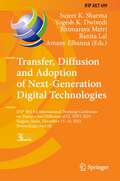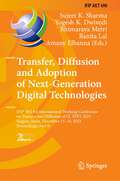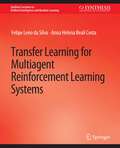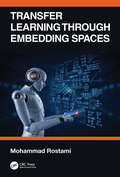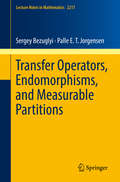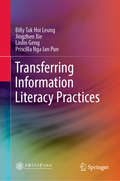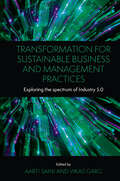- Table View
- List View
Transfer, Diffusion and Adoption of Next-Generation Digital Technologies: IFIP WG 8.6 International Working Conference on Transfer and Diffusion of IT, TDIT 2023, Nagpur, India, December 15–16, 2023, Proceedings, Part III (IFIP Advances in Information and Communication Technology #699)
by Sujeet K. Sharma Yogesh K. Dwivedi Bhimaraya Metri Banita Lal Amany ElbannaThis book constitutes the refereed proceedings of the IFIP WG 8.6 International Working Conference on Transfer and Diffusion of IT, TDIT 2023, which took place in Nagpur, India, in December 2023. The 87 full papers and 23 short papers presented in these proceedings were carefully reviewed and selected from 209 submissions. The papers are organized in the following topical sections: Volume I: Digital technologies (artificial intelligence) adoption; digital platforms and applications; digital technologies in e-governance; metaverse and marketing. Volume II: Emerging technologies adoption; general IT adoption; healthcare IT adoption. Volume III: Industry 4.0; transfer, diffusion and adoption of next-generation digital technologies; diffusion and adoption of information technology.
Transfer, Diffusion and Adoption of Next-Generation Digital Technologies: IFIP WG 8.6 International Working Conference on Transfer and Diffusion of IT, TDIT 2023, Nagpur, India, December 15–16, 2023, Proceedings, Part II (IFIP Advances in Information and Communication Technology #698)
by Sujeet K. Sharma Yogesh K. Dwivedi Bhimaraya Metri Banita Lal Amany ElbannaThis book constitutes the refereed proceedings of the IFIP WG 8.6 International Working Conference on Transfer and Diffusion of IT, TDIT 2023, which took place in Nagpur, India, in December 2023. The 87 full papers and 23 short papers presented in these proceedings were carefully reviewed and selected from 209 submissions. The papers are organized in the following topical sections: Volume I: Digital technologies (artificial intelligence) adoption; digital platforms and applications; digital technologies in e-governance; metaverse and marketing. Volume II: Emerging technologies adoption; general IT adoption; healthcare IT adoption. Volume III: Industry 4.0; transfer, diffusion and adoption of next-generation digital technologies; diffusion and adoption of information technology.
Transfer in Reinforcement Learning Domains (Studies in Computational Intelligence #216)
by Matthew TaylorIn reinforcement learning (RL) problems, learning agents sequentially execute actions with the goal of maximizing a reward signal. The RL framework has gained popularity with the development of algorithms capable of mastering increasingly complex problems, but learning difficult tasks is often slow or infeasible when RL agents begin with no prior knowledge. The key insight behind "transfer learning" is that generalization may occur not only within tasks, but also across tasks. While transfer has been studied in the psychological literature for many years, the RL community has only recently begun to investigate the benefits of transferring knowledge. This book provides an introduction to the RL transfer problem and discusses methods which demonstrate the promise of this exciting area of research. The key contributions of this book are: Definition of the transfer problem in RL domains Background on RL, sufficient to allow a wide audience to understand discussed transfer concepts Taxonomy for transfer methods in RL Survey of existing approaches In-depth presentation of selected transfer methods Discussion of key open questions By way of the research presented in this book, the author has established himself as the pre-eminent worldwide expert on transfer learning in sequential decision making tasks. A particular strength of the research is its very thorough and methodical empirical evaluation, which Matthew presents, motivates, and analyzes clearly in prose throughout the book. Whether this is your initial introduction to the concept of transfer learning, or whether you are a practitioner in the field looking for nuanced details, I trust that you will find this book to be an enjoyable and enlightening read. Peter Stone, Associate Professor of Computer Science
Transfer Learning for Multiagent Reinforcement Learning Systems (Synthesis Lectures on Artificial Intelligence and Machine Learning)
by Felipe Felipe Leno da Silva Anna Helena Anna Helena Reali CostaLearning to solve sequential decision-making tasks is difficult. Humans take years exploring the environment essentially in a random way until they are able to reason, solve difficult tasks, and collaborate with other humans towards a common goal. Artificial Intelligent agents are like humans in this aspect. Reinforcement Learning (RL) is a well-known technique to train autonomous agents through interactions with the environment. Unfortunately, the learning process has a high sample complexity to infer an effective actuation policy, especially when multiple agents are simultaneously actuating in the environment. However, previous knowledge can be leveraged to accelerate learning and enable solving harder tasks. In the same way humans build skills and reuse them by relating different tasks, RL agents might reuse knowledge from previously solved tasks and from the exchange of knowledge with other agents in the environment. In fact, virtually all of the most challenging tasks currently solved by RL rely on embedded knowledge reuse techniques, such as Imitation Learning, Learning from Demonstration, and Curriculum Learning. This book surveys the literature on knowledge reuse in multiagent RL. The authors define a unifying taxonomy of state-of-the-art solutions for reusing knowledge, providing a comprehensive discussion of recent progress in the area. In this book, readers will find a comprehensive discussion of the many ways in which knowledge can be reused in multiagent sequential decision-making tasks, as well as in which scenarios each of the approaches is more efficient. The authors also provide their view of the current low-hanging fruit developments of the area, as well as the still-open big questions that could result in breakthrough developments. Finally, the book provides resources to researchers who intend to join this area or leverage those techniques, including a list of conferences, journals, and implementation tools. This book will be useful for a wide audience; and will hopefully promote new dialogues across communities and novel developments in the area.
Transfer Learning through Embedding Spaces
by Mohammad RostamiRecent progress in artificial intelligence (AI) has revolutionized our everyday life. Many AI algorithms have reached human-level performance and AI agents are replacing humans in most professions. It is predicted that this trend will continue and 30% of work activities in 60% of current occupations will be automated. This success, however, is conditioned on availability of huge annotated datasets to training AI models. Data annotation is a time-consuming and expensive task which still is being performed by human workers. Learning efficiently from less data is a next step for making AI more similar to natural intelligence. Transfer learning has been suggested a remedy to relax the need for data annotation. The core idea in transfer learning is to transfer knowledge across similar tasks and use similarities and previously learned knowledge to learn more efficiently. In this book, we provide a brief background on transfer learning and then focus on the idea of transferring knowledge through intermediate embedding spaces. The idea is to couple and relate different learning through embedding spaces that encode task-level relations and similarities. We cover various machine learning scenarios and demonstrate that this idea can be used to overcome challenges of zero-shot learning, few-shot learning, domain adaptation, continual learning, lifelong learning, and collaborative learning.
Transfer Learning through Embedding Spaces
by Mohammad RostamiRecent progress in artificial intelligence (AI) has revolutionized our everyday life. Many AI algorithms have reached human-level performance and AI agents are replacing humans in most professions. It is predicted that this trend will continue and 30% of work activities in 60% of current occupations will be automated. This success, however, is conditioned on availability of huge annotated datasets to training AI models. Data annotation is a time-consuming and expensive task which still is being performed by human workers. Learning efficiently from less data is a next step for making AI more similar to natural intelligence. Transfer learning has been suggested a remedy to relax the need for data annotation. The core idea in transfer learning is to transfer knowledge across similar tasks and use similarities and previously learned knowledge to learn more efficiently. In this book, we provide a brief background on transfer learning and then focus on the idea of transferring knowledge through intermediate embedding spaces. The idea is to couple and relate different learning through embedding spaces that encode task-level relations and similarities. We cover various machine learning scenarios and demonstrate that this idea can be used to overcome challenges of zero-shot learning, few-shot learning, domain adaptation, continual learning, lifelong learning, and collaborative learning.
Transfer Operators, Endomorphisms, and Measurable Partitions (Lecture Notes in Mathematics #2217)
by Sergey Bezuglyi Palle E. JorgensenThe subject of this book stands at the crossroads of ergodic theory and measurable dynamics. With an emphasis on irreversible systems, the text presents a framework of multi-resolutions tailored for the study of endomorphisms, beginning with a systematic look at the latter. This entails a whole new set of tools, often quite different from those used for the “easier” and well-documented case of automorphisms. Among them is the construction of a family of positive operators (transfer operators), arising naturally as a dual picture to that of endomorphisms. The setting (close to one initiated by S. Karlin in the context of stochastic processes) is motivated by a number of recent applications, including wavelets, multi-resolution analyses, dissipative dynamical systems, and quantum theory. The automorphism-endomorphism relationship has parallels in operator theory, where the distinction is between unitary operators in Hilbert space and more general classes of operators such as contractions. There is also a non-commutative version: While the study of automorphisms of von Neumann algebras dates back to von Neumann, the systematic study of their endomorphisms is more recent; together with the results in the main text, the book includes a review of recent related research papers, some by the co-authors and their collaborators.
Transferring Human Impedance Regulation Skills to Robots (Springer Tracts in Advanced Robotics #110)
by Arash AjoudaniThis book introduces novel thinking and techniques to the control of robotic manipulation. In particular, the concept of teleimpedance control as an alternative method to bilateral force-reflecting teleoperation control for robotic manipulation is introduced. In teleimpedance control, a compound reference command is sent to the slave robot including both the desired motion trajectory and impedance profile, which are then realized by the remote controller. This concept forms a basis for the development of the controllers for a robotic arm, a dual-arm setup, a synergy-driven robotic hand, and a compliant exoskeleton for improved interaction performance.
Transferring Information Literacy Practices
by Billy Tak Leung Jingzhen Xie Linlin Geng Priscilla Nga PunThis book focuses on information literacy for the younger generation of learners and library readers. It is divided into four sections: 1. Information Literacy for Life; 2. Searching Strategies, Disciplines and Special Topics; 3. Information Literacy Tools for Evaluating and Utilizing Resources; 4. Assessment of Learning Outcomes. Written by librarians with wide experience in research and services, and a strong academic background in disciplines such as the humanities, social sciences, information technology, and library science, this valuable reference resource combines both theory and practice. In today's ever-changing era of information, it offers students of library and information studies insights into information literacy as well as learning tips they can use for life.
Transfersysteme zur Hochleistungskommunikation
by Bernd HeinrichsIm vorliegenden Buch werden Protokolle für die Kommunikation in Hochgeschwindigkeitsnetzen vorgestellt. Das Buch ist daher für den Ingenieur und Wissenschaftler, der mit Fragen der Multimediakommunikation befaßt ist, von Interesse.
Transform Your Business into E
by Bennet Lientz Kathryn ReaSurveys indicate that many E-Business efforts either fail or disrupt the basic business processes and transactions. E-Business is sometimes not aligned with the business or IT. Vague vision statements are not translated into specific actions related to E- Business. It is because of these factors that Transform Your Business into e was written. The book covers E-Business from the review of the business at the start to expanding E-Business after it is live.
Transform Your Business into E
by Bennet Lientz Kathryn ReaSurveys indicate that many E-Business efforts either fail or disrupt the basic business processes and transactions. E-Business is sometimes not aligned with the business or IT. Vague vision statements are not translated into specific actions related to E- Business. It is because of these factors that Transform Your Business into e was written. The book covers E-Business from the review of the business at the start to expanding E-Business after it is live.
Transformation and Your New EHR: The Communications and Change Leadership Playbook for Implementing Electronic Health Records (HIMSS Book Series)
by Dennis R. Delisle Andy McLamb Samantha InchTransformation and Your New EHR offers a robust communication and change leadership approach to support electronic health record (EHR) implementations and transformation journeys. This book highlights the approach and philosophy of communication, change leadership, and systems and process design, giving readers a practical view into the successes and failures that can be experienced throughout the evolution of an EHR implementation.
Transformation and Your New EHR: The Communications and Change Leadership Playbook for Implementing Electronic Health Records (HIMSS Book Series)
by Dennis R. Delisle Andy McLamb Samantha InchTransformation and Your New EHR offers a robust communication and change leadership approach to support electronic health record (EHR) implementations and transformation journeys. This book highlights the approach and philosophy of communication, change leadership, and systems and process design, giving readers a practical view into the successes and failures that can be experienced throughout the evolution of an EHR implementation.
Transformation-Based Reactive Systems Development: 4th International AMAST Workshop on Real-Time Systems and Concurrent and Distributed Software, ARTS'97, Palma, Mallorca, Spain, May 21 - 23, 1997, Proceedings (Lecture Notes in Computer Science #1231)
by Miquel Bertran Teodor RusThis book constitutes the refereed proceedings of the Fourth International AMAST Workshop on Real-Time Systems and Concurrent and Distributed Software, ARTS'97, held in Palma de Mallorca, Spain, in May 1997.The volume presents 24 carefully selected revised full papers. Also included are two historical contributions honoring Ramon Llull, who was born on Mallorca, as well as two invited papers. All current issues in the field of formal methods for real-time systems and distributed and concurrent systems are addressed.
Transformation for Sustainable Business and Management Practices: Exploring the Spectrum of Industry 5.0
by Aarti Saini and Vikas GargSince the introduction of Industry 5.0, there has been a greater emphasis on the human-centric view in human-machine collaboration. As society has benefitted from technological advancements in all aspects of industrial sectors, there has been a rethinking of the role human beings should play in future evolutions. This includes the skills or knowledge the workforce should adopt in training, and how the positive outcomes of such advancements can be maximized in the economy whilst mitigating the negative ethical and social consequences. Transformation for Sustainable Business and Management Practices: Exploring the Spectrum of Industry 5.0 provides an understanding of the foundations of these predicted changes; how the transformation started, evolved, and accelerated over time.
Transformation for Sustainable Business and Management Practices: Exploring the Spectrum of Industry 5.0
by Aarti Saini Vikas GargSince the introduction of Industry 5.0, there has been a greater emphasis on the human-centric view in human-machine collaboration. As society has benefitted from technological advancements in all aspects of industrial sectors, there has been a rethinking of the role human beings should play in future evolutions. This includes the skills or knowledge the workforce should adopt in training, and how the positive outcomes of such advancements can be maximized in the economy whilst mitigating the negative ethical and social consequences. Transformation for Sustainable Business and Management Practices: Exploring the Spectrum of Industry 5.0 provides an understanding of the foundations of these predicted changes; how the transformation started, evolved, and accelerated over time.
Transformation in Healthcare with Emerging Technologies
by Kirti Seth Pushpa Singh Divya MishraThe book, Transformation in Healthcare with Emerging Technologies, presents healthcare industrial revolution based on service aggregation and virtualisation that can transform the healthcare sector with the aid of technologies such as Artificial Intelligence (AI), Internet of Things (IoT), Bigdata and Blockchain. These technologies offer fast communication between doctors and patients, protected transactions, safe data storage and analysis, immutable data records, transparent data flow service, transaction validation process, and secure data exchanges between organizations. Features: • Discusses the Integration of AI, IoT, big data and blockchain in healthcare industry • Highlights the security and privacy aspect of AI, IoT, big data and blockchain in healthcare industry • Talks about challenges and issues of AI, IoT, big data and blockchain in healthcare industry • Includes several case studies It is primarily aimed at graduates and researchers in computer science and IT who are doing collaborative research with the medical industry. Industry professionals will also find it useful.
Transformation in Healthcare with Emerging Technologies
by Kirti Seth Pushpa Singh Divya MishraThe book, Transformation in Healthcare with Emerging Technologies, presents healthcare industrial revolution based on service aggregation and virtualisation that can transform the healthcare sector with the aid of technologies such as Artificial Intelligence (AI), Internet of Things (IoT), Bigdata and Blockchain. These technologies offer fast communication between doctors and patients, protected transactions, safe data storage and analysis, immutable data records, transparent data flow service, transaction validation process, and secure data exchanges between organizations. Features: • Discusses the Integration of AI, IoT, big data and blockchain in healthcare industry • Highlights the security and privacy aspect of AI, IoT, big data and blockchain in healthcare industry • Talks about challenges and issues of AI, IoT, big data and blockchain in healthcare industry • Includes several case studies It is primarily aimed at graduates and researchers in computer science and IT who are doing collaborative research with the medical industry. Industry professionals will also find it useful.
Transformation of Collective Intelligences: Perspective of Transhumanism
by Jean-Max NoyerThere is a great transformation of the production of knowledge and intelligibility. The "digital fold of the world" (with the convergence of NBIC) affects the collective assemblages of “thought”, of research. The aims of these assemblages are also controversial issues. From a general standpoint, these debates concern “performative science and performative society”. But one emerges and strengthens that has several names: transhumanism, post-humanism, speculative post-humanism. It appears as a great narration, a large story about the future of our existence, facing our entry into the Anthropocene. It is also presented as a concrete utopia with an anthropological and technical change. In this book, we proposed to show how collective intelligences stand in the middle of the coupling of ontological horizons and of the “process of bio-technical maturation”.
Transformation of Collective Intelligences: Perspective of Transhumanism
by Jean-Max NoyerThere is a great transformation of the production of knowledge and intelligibility. The "digital fold of the world" (with the convergence of NBIC) affects the collective assemblages of “thought”, of research. The aims of these assemblages are also controversial issues. From a general standpoint, these debates concern “performative science and performative society”. But one emerges and strengthens that has several names: transhumanism, post-humanism, speculative post-humanism. It appears as a great narration, a large story about the future of our existence, facing our entry into the Anthropocene. It is also presented as a concrete utopia with an anthropological and technical change. In this book, we proposed to show how collective intelligences stand in the middle of the coupling of ontological horizons and of the “process of bio-technical maturation”.
Transformation operativer Daten zur Nutzung im Data Warehouse
by Jochen MüllerJochen Müller vergleicht charakteristische Merkmale operativer und analyseorientierter Informationssysteme und untersucht die besondere Bedeutung der Schnittstellen zu den datenliefernden Vorsystemen.
Transformation von Unternehmen und Technologie: Wie sich die Daten- und Prozess-Migration erfolgreich steuern und umsetzen lässt
by Georg Panagos Christian HammerDieses Buch gibt einen systematischen Überblick zu Strategien und Methoden bei digitalen Transformationen und zeigt dabei auch typische Probleme, Fallstricke sowie Erfolgsfaktoren bei der IT- und Geschäftsprozess-Migration. Anhand zahlreicher Praxisbeispiele beschreibt es anschaulich das Vorgehen im Migrationsmanagement und die Einbeziehung von Mitarbeitern in den Veränderungsprozess. Der Transformationsprozess bedeutet für Unternehmen, Geschäftsmodelle zu verändern oder komplett neu aufzustellen. Die dabei entstehenden neuen Prozesse und Daten sowie deren Verarbeitung müssen so gestaltet sein, dass sie die Wirklichkeit und deren Veränderung jederzeit abbilden. Das Buch richtet sich an Projektleiter, IT-Manager, Produktmanager und Projektmitarbeiter mit dem Ziel, ein besseres Verständnis ihres Vorhabens zu entwickeln, um Projekte besser beurteilen und planen zu können.
Transformational Security Awareness: What Neuroscientists, Storytellers, and Marketers Can Teach Us About Driving Secure Behaviors
by Perry CarpenterExpert guidance on the art and science of driving secure behaviors Transformational Security Awareness empowers security leaders with the information and resources they need to assemble and deliver effective world-class security awareness programs that drive secure behaviors and culture change. When all other processes, controls, and technologies fail, humans are your last line of defense. But, how can you prepare them? Frustrated with ineffective training paradigms, most security leaders know that there must be a better way. A way that engages users, shapes behaviors, and fosters an organizational culture that encourages and reinforces security-related values. The good news is that there is hope. That’s what Transformational Security Awareness is all about. Author Perry Carpenter weaves together insights and best practices from experts in communication, persuasion, psychology, behavioral economics, organizational culture management, employee engagement, and storytelling to create a multidisciplinary masterpiece that transcends traditional security education and sets you on the path to make a lasting impact in your organization. Find out what you need to know about marketing, communication, behavior science, and culture management Overcome the knowledge-intention-behavior gap Optimize your program to work with the realities of human nature Use simulations, games, surveys, and leverage new trends like escape rooms to teach security awareness Put effective training together into a well-crafted campaign with ambassadors Understand the keys to sustained success and ongoing culture change Measure your success and establish continuous improvements Do you care more about what your employees know or what they do? It's time to transform the way we think about security awareness. If your organization is stuck in a security awareness rut, using the same ineffective strategies, materials, and information that might check a compliance box but still leaves your organization wide open to phishing, social engineering, and security-related employee mistakes and oversights, then you NEED this book.
Transformational Security Awareness: What Neuroscientists, Storytellers, and Marketers Can Teach Us About Driving Secure Behaviors
by Perry CarpenterExpert guidance on the art and science of driving secure behaviors Transformational Security Awareness empowers security leaders with the information and resources they need to assemble and deliver effective world-class security awareness programs that drive secure behaviors and culture change. When all other processes, controls, and technologies fail, humans are your last line of defense. But, how can you prepare them? Frustrated with ineffective training paradigms, most security leaders know that there must be a better way. A way that engages users, shapes behaviors, and fosters an organizational culture that encourages and reinforces security-related values. The good news is that there is hope. That’s what Transformational Security Awareness is all about. Author Perry Carpenter weaves together insights and best practices from experts in communication, persuasion, psychology, behavioral economics, organizational culture management, employee engagement, and storytelling to create a multidisciplinary masterpiece that transcends traditional security education and sets you on the path to make a lasting impact in your organization. Find out what you need to know about marketing, communication, behavior science, and culture management Overcome the knowledge-intention-behavior gap Optimize your program to work with the realities of human nature Use simulations, games, surveys, and leverage new trends like escape rooms to teach security awareness Put effective training together into a well-crafted campaign with ambassadors Understand the keys to sustained success and ongoing culture change Measure your success and establish continuous improvements Do you care more about what your employees know or what they do? It's time to transform the way we think about security awareness. If your organization is stuck in a security awareness rut, using the same ineffective strategies, materials, and information that might check a compliance box but still leaves your organization wide open to phishing, social engineering, and security-related employee mistakes and oversights, then you NEED this book.
